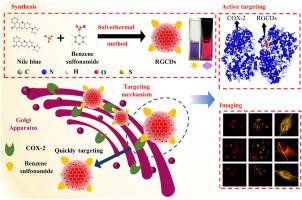高尔基靶红发射碳点:合成、性质和生物成像
IF 4.2
3区 工程技术
Q2 CHEMISTRY, APPLIED
引用次数: 0
摘要
高尔基靶向碳点由于其独特的光致发光特性、特异的高尔基靶向能力和良好的生物相容性,在亚细胞细胞器成像领域引起了广泛的关注。目前报道的高尔基靶向碳点主要表现出蓝色和橙色光谱区域的发射波长,由于内源性组织自身荧光的干扰和有限的组织穿透,其成像精度降低。为了克服这些缺点,采用溶剂热法合成了红色高尔基靶向碳点(RGCDs),以尼罗河蓝(一种以其大共轭结构而闻名的荧光染料)为碳源,苯磺酰胺(一种已知的高尔基靶向配体)为靶向片段。结果表明,RGCDs具有优异的光学性能,发射波长以645 nm为中心。此外,RGCDs具有较低的细胞毒性,在400 μg/mL浓度下,兔肝癌细胞存活率保持在80%以上。此外,与商业高尔基靶染料共定位成像的Pearson相关系数为0.87,表明RGCDs具有长波发射和特定高尔基靶能力。此外,AutoDock模拟分析证实,rgcd表面的磺胺基团与环氧化酶-2(一种已知的高尔基相关蛋白)结合,增强了rgcd的成像能力。本文章由计算机程序翻译,如有差异,请以英文原文为准。

Golgi-targeting red-emissive carbon dots: synthesis, properties and bioimaging
Golgi-targeting carbon dots have garnered significant attention in the field of subcellular organelle imaging owing to their exceptional photoluminescence properties, specific Golgi-targeting abilities, and favorable biocompatibility. Currently reported Golgi-targeting carbon dots primarily exhibit emission wavelengths in the blue and orange spectral regions, which suffer from reduced imaging accuracy because of interference from endogenous tissue autofluorescence and limited tissue penetration. To overcome these disadvantages, red-emissive Golgi-targeting carbon dots (RGCDs) were synthesized using a solvothermal method, with Nile blue, a fluorescent dye known for its large conjugated structure, as the carbon source, and benzene sulfonamide, a known Golgi-targeting ligand, as the targeting moiety. Results demonstrate that RGCDs exhibit superior optical properties, with an emission wavelength centered at 645 nm. Moreover, RGCDs exhibit low cytotoxicity, with rabbit hepatocarcinoma cell viability remaining above 80 % at a concentration of 400 μg/mL. Furthermore, co-localization imaging with a commercial Golgi-targeting dye yielded a high Pearson correlation coefficient of 0.87, indicating that RGCDs possess both long-wavelength emission and specific Golgi targeting capabilities. Additionally, AutoDock simulation analysis confirmed that the sulfonamide groups on the surface of the RGCDs bind to cyclooxygenase-2, a known Golgi-associated protein, enhancing the imaging capabilities of RGCDs.
求助全文
通过发布文献求助,成功后即可免费获取论文全文。
去求助
来源期刊

Dyes and Pigments
工程技术-材料科学:纺织
CiteScore
8.20
自引率
13.30%
发文量
933
审稿时长
33 days
期刊介绍:
Dyes and Pigments covers the scientific and technical aspects of the chemistry and physics of dyes, pigments and their intermediates. Emphasis is placed on the properties of the colouring matters themselves rather than on their applications or the system in which they may be applied.
Thus the journal accepts research and review papers on the synthesis of dyes, pigments and intermediates, their physical or chemical properties, e.g. spectroscopic, surface, solution or solid state characteristics, the physical aspects of their preparation, e.g. precipitation, nucleation and growth, crystal formation, liquid crystalline characteristics, their photochemical, ecological or biological properties and the relationship between colour and chemical constitution. However, papers are considered which deal with the more fundamental aspects of colourant application and of the interactions of colourants with substrates or media.
The journal will interest a wide variety of workers in a range of disciplines whose work involves dyes, pigments and their intermediates, and provides a platform for investigators with common interests but diverse fields of activity such as cosmetics, reprographics, dye and pigment synthesis, medical research, polymers, etc.
 求助内容:
求助内容: 应助结果提醒方式:
应助结果提醒方式:


